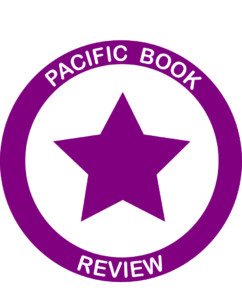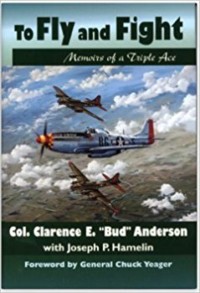Title: To Fly and Fight: Memoirs of a Triple Ace
Author: C. E. “Bud” Anderson
Publisher: XlibrisUS
ISBN-13: 978-1-5245-6342-4
Pages: 276
Genre: Memoir, Military History
Reviewed by: Jason Lulos
Pacific Book Review Star
Awarded to Books of Excellent Merit

Just a great book about an absolutely fascinating man, Col. Clarence E. “Bud” Anderson, who happens to be one of the greatest pilots of World War II. To Fly and Fight: Memoirs of a Triple Ace is specifically riveting to readers interested in World War II and aviation, but also I would recommend this as a great autobiography, plain and simple.
Clarence Anderson was a farm boy growing up dreaming of being a pilot and he achieves this dream, numerous honors, and lives an adventurous life. Chuck Yeager called him the “best fighter pilot I’ve ever seen.” Anderson charts his life on the farm to World War II and then to his life as a test pilot, all while raising a family with his wife Ellie. To fly and fight in Europe in World War II, at such a young age and to be so successful – said by many to be the best ever, seems to have required a paradoxical trait – focused recklessness. Maybe “creative discipline” is a better description of the trait. Also he had, what is called, “apprehensive fearlessness.” Anderson along with co-author Joseph P. Hamelin has articulated these characteristics in a great book which I most honestly suggest others to read.
“World War Two was a total thing, us against them, when being against them was unquestionably the right thing to be. I flew for my country, and was proud I could help in any way that I could.” Here, Bud details the bonds with the other fighters and the crew: the famous 357th. Dealing with the constant presence and potential of death, it is told with honesty, pride, and humility. He discusses the camaraderie – living in steel Nissen huts, flying state of the art aircraft, danger, adventure, drinking, dealing with loss, grieving and moving on to repeat it. Proudly serving two tours for Col. Anderson, the second one being completely voluntarily.
In the second part of the book, “Bud” writes of his life as a test pilot and his stint in Vietnam – both interesting as well, although he loathed the post WWII times when he had to “fly a desk.” These were what you might call his “Ulysses” (Tennyson) stages (“How dull it is to pause” etc.) – times when he longed to be flying again. Bud adamantly loves being with his family and he details the struggle to maintain that balance of family and career. Despite the periodic desk jobs, he’s managed to continue flying, one way or another, for much of his life. He has remained great friends with Chuck Yeager and others he flew with in the war. He even formed a friendship with German WWII ace Günther Rall.
This memoir is interspersed with letters and interviews which sometimes jump around in time, but they are perfectly interwoven and it never interrupts the flow of the book. This book is highly recommended and one which will never be forgotten.


